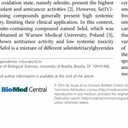Speciation of Selenium in Selenium-Enriched Sunflower Oil by High-Performance Liquid Chromatography-Inductively Coupled Plasma Mass Spectrometry/Electrospray-Orbitrap Tandem Mass Spectrometry.
Avainsanat
Abstrakti
The reaction of sunflower oil with selenite produces a complex mixture of selenitriglycerides with antioxidant and anticancer properties. To obtain insight into the identity and characteristics of the species formed, an analytical approach based on the combination of high-performance liquid chromatography (HPLC) with (78)Se-specific selenium detection by inductively coupled plasma mass spectrometry (ICP MS) and high-resolution (100 000), high mass accuracy (<1 ppm) molecule-specific detection by electrospray-Orbitrap MS(3) was developed. For the first time, a non-aqueous mobile phase gradient was used in reversed-phase HPLC-ICP MS for the separation of a complex mixture of selenospecies and a mathematical correction of the background signal was developed. The identical chromatographic conditions served for the sample introduction into electrospray MS. Two types of samples were analyzed: sunflower oil dissolved in isopropanol and methanol extract of the oil containing 65% selenium. HPLC-ICP MS showed 14 peaks, 11 of which could also be detected in the methanol extract. Isotopic patterns corresponding to molecules with one or two selenium atoms could be attributed by Orbitrap MS at the retention times corresponding to the HPLC-ICP MS peak apexes. Structural data for these species were acquired by MS(2) and MS(3) fragmentation of protonated or sodiated ions using high-energy collisional dissociation (HCD). A total of 11 selenium-containing triglycerol derivatives resulting from the oxidation of one or two double bonds of linoleic acid and analogous derivatives of glycerol-mixed linoleate(s)/oleinate(s) have been identified for the first time. The presence of these species was confirmed by the targeted analysis in the total oil isopropanol solution. Their identification corroborated the predicted elution order in reversed-phase chromatography: LLL (glycerol trilinoleate), LLO (glycerol dilinoleate-oleinate), LOO (glycerol linoleate-dioleinate), OOO (glycerol trioleinate), of which the extrapolation allowed for the prediction of the identity [glycerol dioleinate-stearate (OOS) and glycerol oleinate-distearate (OSS)] of the nonpolar species detected by ICP MS in the oil but not detected by electrospray MS.


